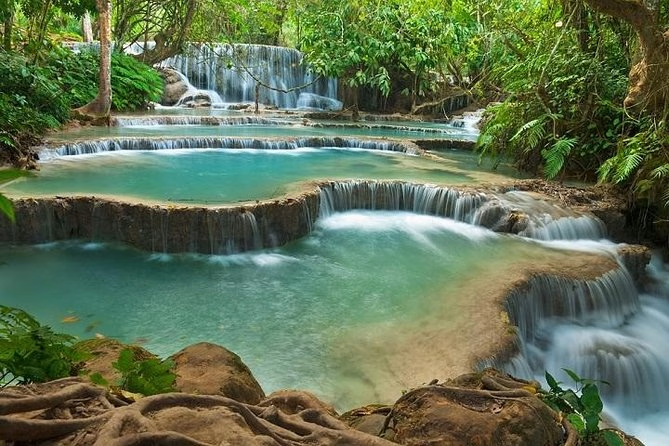Nature offers us a variety of spectacular natural swimming spots, which have been created over thousands of years due to the action of natural elements, resulting in naturally created lakes, cenotes, beaches and waterfalls. Therefore, we decided at Clear Water Revival to compile a list of our top ten natural swimming spots in the world;
1. The Devil’s Pool – Victoria Falls, Zimbabwe
Kicking off our top ten list of CWR’s favourite natural swimming spots with at a water flow rate of 500 million litres per minute and a width of almost 1 mile, is Victoria Falls. Victoria Falls is one of the largest waterfalls in the world, twice the height of Niagara Falls and at the edge of this enormous water, is a natural rock pool called the ‘Devil’s Pool’. This pool is a small 328 feet high lagoon abutting one of the biggest waterfalls in the world, emphasising the epitome of ‘living on the edge’ formed as a result of thousands of years of erosion, although the natural rock wall at the edge of the waterfall will stop you from being swept down. During the dry season, when the water level drops, you can safely swim in the Devil’s pool.

2. Havasu Falls – Grand Canyon, Arizona
Located in the Grand Canyon, within Native American (Havasupai) tribal lands, Havasu Falls is an oasis in the hot and dry Grand Canyon National Park, Arizona. The Havasu Falls is a picturesque waterfall renowned for its surrounding red rocks and vivid blue-green coloured water caused by the high concentration of calcium carbonate. Once called the Bridal Veil Falls, this was changed due to a flash flood, that changed the canyons appearance. It consists of one waterfall chute that drops over a 90 to 100-foot cliff into a large pool below.

3. Hidden Beach – Marieta Islands, Mexico
Located in the Marieta Islands a few miles off the coast of Nayarit, Mexico, Hidden Beach is an open sun-drenched crater that can only be accessed when the tide is low. Technically, the Hidden Beach is an artificial made pool, as it was created by an explosion of a bomb that accidentally landed there during military trials. Nevertheless, it’s a sight to see!

4. To Sua Ocean Trench – Lotofaga, Somoa
Located in Somoa’s Lotofaga Village on the island of Upola, formed by a big basaltic shield volcano, To Sua Ocean Trench is an all-natural swimming hole with a visitor friendly ladder and small dock (translated to ‘large swimming hole’). Surrounded by lush gardens, this trench is filled with fish, crabs, and lots of other marine life.
With a depth of 30 meters, the water of To Sua Ocean Trench is clear and has a beautiful blue colouration. Most likely, its origins date from a time when volcanoes erupted and covered the nearby shores with lava making the ground collapse, leaving behind a 30 meters deep hole, which connects with the ocean through underground canals.

5. Semuc Champey – Lanquin, Guatemala
Sitting 11km south of the town of Lanquin, in central Guatemala, lies a natural watermark called the Semuc Champey. The Semuc Champey natural monument boasts six stunning tiered turquoise pools, an extensive cave network complete with underground waterfalls, and breath-taking views. The shockingly blue pools rest on top of a natural limestone bridge covering a portion of the Cahabón River.

6. Giola – Thassos, Greece
On the Greek island of Thassos lies a secluded natural sea lagoon, near the villa of Astris, called Giola. Carved into rocks that tower 8m high in certain parts, the pool is filled with emerald green water that is a few degrees warmer than the Aegean Sea, which it overlooks. Legend says that the pool was created by the Greek god Zeus, and Aphrodite went swimming there, so it is also known as “The Tear of Aphrodite.” According to another legend, the pool is the eye through which Zeus watched over his mistress. This natural swimming pool is extremely popular with day trippers, although the pool is not easily accessible.

7. Cenote Ik-Kil – Yucatan, Mexico
This natural pool, located in the ancient city of Yucatan in Mexico near the remains of Chichen Itza, is one of the most popular natural swimming pools in the world. Formed by the collapsing of a limestone cave, this 60-metre-wide cenote has a depth of 35 metres, which is 56 metres below ground level.
Cenotes are natural swimming holes that had particular significance to the Mayan communities in Mexico’s Yucatan Peninsula. Thought to be sacred wells, the Mayan’s believe that they were a portal to speak to the gods and the waters of Ik-Kil were considered sacred by the Mayans who performed human sacrifices to their rain god, Chaac, as bones and jewellery were found in the deep waters of this cenote by archaeologists and speleologists. Although, this cenote unlike many others, is open to the sky and the sunlight turns the water a bright teal colour.

8. Grotta Della Poesia – Roca Vecchia, Italy
According to legend, a stunning muse bathed in this constellation of lime pools, known as the Grotta Della Poesia (Grotto of Poetry). However, the 600 square meter natural pool is excavated by years of continous action of sea and is located on the edge of the Adriatic Sea. Located about 20km from the historic city of Lecce, the cave is also an important archaeological site, featuring hundreds of Messapic, Greek and Latin inscriptions.
9. Hamilton Pool Reserve – Dripping Springs, Texas
Just outside of Austin, Texas, sits this incredible natural pool within 232 acres of a protected area, which was formed when the dome of an underground river collapsed due to massive erosion thousands of years ago. The pool itself has beautiful green waters, surrounded by towering limestone slabs, has a small waterfall spilling from the limestone roof and has large stalactites growing from the ceiling. Hamilton Pool Preserve is also part of the Balcones Canyonlands Preserve and is home to a variety of birds and diverse vegetation.

10. Kuang Si Falls – Luang Prabang, North Central Laos
Finishing off our top ten natural swimming spots in the world is Kuang Si Falls. Kuang Si Falls is a series of three beautiful waterfalls surrounded by lush tropical jungle approximately 29 kilometres south of the Luang Prabang city of Laos. The falls begin in a shallow pool atop a steep hillside which leads to the main fall with a 60 metre (200ft) drop. You can see spectacular cascades of water, and during the dry season, you can see beautiful turquoise and green coloured water, due to the mixing of minerals to the water. Additionally, the pools are perfect for swimming in the summer, because of the cold temperature and the sparkling turquoise waters.


